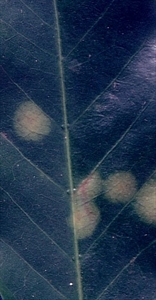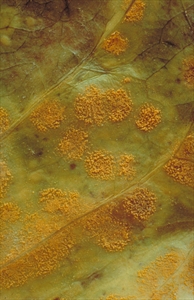Coffee leaf rust
Pacific Pests, Pathogens, Weeds & Pesticides - Online edition
Pacific Pests, Pathogens, Weeds & Pesticides
Coffee rust (141)
Hemileia vastatrix
Asia, Africa, North, South and Central America, the Caribbean, Oceania. It is recorded from American Samoa, Cook Islands, Fiji, French Polynesia, New Caledonia, Papua New Guinea, Samoa, and Vanuatu.
Coffee arabica, Coffea canephora
At first, the spots are 2-3 mm diameter, expanding up to 15 mm diameter, and forming yellow-orange powdery blotches on the underside of leaves and yellow areas on top (Photos 1&2). Later, the centres of the spots on the top turn brown with yellow margins. Blotches may merge and cover the leaf blade. In severely affected plants, leaves fall and branches die back.
Spores are produced in the yellow-orange blotches on the under surface of leaves (Photo 3). They are spread by wind, but require water for germination. Insects also spread them. In countries where there is a dry season, the spores survive in infected leaves.
The disease is severe on arabica coffee, especially when grown in warm, moist areas in the lowlands (under 1500 m above sea level). Infection causes leaf fall, and this in turn affects the growth of new stems, which bear the next season's crop.
Damage of a different kind occurs if there is a rust epidemic on trees with high yields. It is called 'overbearing dieback'. Loss of leaves leads to movement of food from the shoots and roots into the berries, which may ripen prematurely, resulting in beans of poor quality. Overbearing dieback may eventually kill the trees.
Plants weakened by rust are also more susceptible to attack by anthracnose (another fungus), which is not normally the cause of a serious disease. Overall, a 30 to 50% reduction in yield is possible from coffee rust.
Look for the spots on the leaves, especially the yellow-orange spots on the underside of the leaves, and the brown spots with yellow margins above.
Factors that affect the severity of rust disease are: i) amount of rainfall; ii) the numbers of infected leaves at the beginning of an epidemic to supply spores; and iii) the amount of foliage on the trees.
QUARANTINE
A new strain of the fungus has emerged in Central America (and perhaps some countries in South America) which is adapted to higher altitudes, and also has some resistance to fungicides.
CULTURAL CONTROL
Cultural control is important; there are a number of ways that it can be used to reduce the impact of coffee leaf rust:
- Tree spacing: If trees are too close then the disease develops faster because the leaves remain moist longer, and this increases the number of spores that germinate.
- Nutrition: It is important that the trees have the nutrients needed. High-yielding trees are especially susceptible to rust if they are not well fertilized. The trees transfer foods to the berries, and this weakens the tree, making them vulnerable to other diseases.
- Shade: Excessive shade increases rust disease as it keeps leaves moist for longer, and this also increases the number of spores that germinate.
RESISTANT VARIETIES
Robusta coffee varieties are generally resistance to all races of coffee leaf rust. Natural hybrids between arabica and robusta species, and these, too, are resistant to most rust races. They have been used in breeding programs to produce catimor (crosses between Timor and Caturra varieties) and other hybrids.
CHEMICAL CONTROL
In general, chemical control is not required in plantations above 1700 m because of the lower temperatures. Where fungicides are used, applications are made at 4-6 weekly intervals. However, the need for chemical control depends on the varieties grown. For instance, if Catimor hybrids are grown there is little need for chemical control.
If chemical control is required, use:
-
Protectant products: Copper products were the first to be used against rust, and are still widely applied.
-
Systemic products: Trialzole fungicides.
Note, that copper fungicides may kill the insects that give biological control of the green scale insect, Coccus viridis.
____________________
When using a pesticide, always wear protective clothing and follow the instructions on the product label, such as dosage, timing of application, and pre-harvest interval. Recommendations will vary with the crop and system of cultivation. Expert advice on the most appropriate pesticides to use should always be sought from local agricultural authorities.
AUTHOR Grahame Jackson
Information (and Photos 1&2) from Gerlach WWP (1988) Plant diseases of Western Samoa. Samoan German Crop Protection Project, Deutsche Gesellschaft für Technische Zusammenarbeit (GTZ) Gmbh, Germany; and CABI (2020) Hemileia vastatrix (coffee leaf rust). Crop Protection Compendium. (https://www.cabi.org/cpc/datasheet/26865); and Arneson PA (2000) Coffee rust. The Plant Health Instructor. (https://www.apsnet.org/edcenter/disandpath/fungalbasidio/pdlessons/Pages/CoffeeRust.aspx); and from Hemileia vastatrix. Wikipedia. (https://en.wikipedia.org/wiki/Hemileia_vastatrix). Photo 3 Kohler F, et al. (1997) Diseases of cultivated crops in Pacific Island countries. South Pacific Commission. Pirie Printers Pty Limited, Canberra, Australia.
Produced with support from the Australian Centre for International Agricultural Research under project PC/2010/090: Strengthening integrated crop management research in the Pacific Islands in support of sustainable intensification of high-value crop production, implemented by the University of Queensland and the Secretariat of the Pacific Community.






